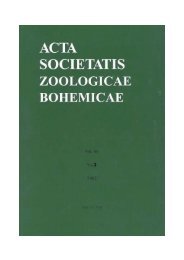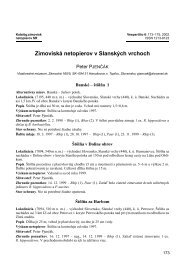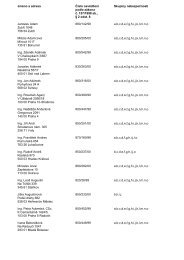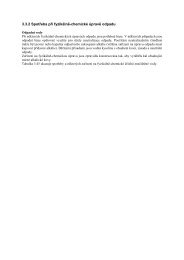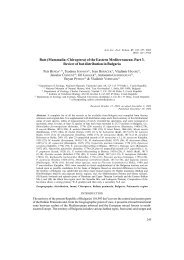You also want an ePaper? Increase the reach of your titles
YUMPU automatically turns print PDFs into web optimized ePapers that Google loves.
Arthropods of Burgess Shale type from the Middle Cambrian of Bohemia (Czech Republic)30 mmFig. 6. Schematic drawing of remains of the large tuzoiid arthropod Tuzoidae n. gen.? (L36595) from Vinice near Jince, Paradoxides gracilis Zone(coll. M. Široký).ly concave subcircular depressions terminated by medianpits (pl. IIIC). The density of depressions is around 6–8 in10 mm. The areas with large polygons and those with pittingare connected and distinguished by smaller reticulaebut the differences are very marked.Although the fossil is flattened, traces of the primarymorphology are partly preserved: the two median bandswith dense sculpture are slightly raised, the main reticulateareas are flat and the outer, marginal bands with densesculpture are moderately bent downwards on both sides ofthe specimen. Remains of paradoxidid trilobites (librigenae,thoracic segments, parts of cephala) are imprinted intothe evidently thin reticulate areas of the shield.Measurements: The total width of the fossil is227 mm; maximum length, measured parallel to the bandsof different sculpture, is 123 mm. The preserved transversewidth of bands with dense sculpture on the outer sides ofboth presumed valves is 26 mm and the inner bands withdense sculpture attain a maximum width of 17 mm.Remarks. As the original margins are not preserved,the interpretation of the fossil is ambiguous. Even in interpretationas two valves of a bivalve arthropod exist twopossibilities:1. The areas with dense sculpture situated in median partof the fossil indicate areas in proximity and along thedorsal margins of valves, the large flat areas with largereticulae represent most of the surface of both carapacevalves, and the densely sculptured outer bands correspondto marginal parts of valves near their ventral margin.In this case, the presumed dorsoventral width ofindividual valves can be calculated as c. from 100 to110 mm, length as 150 to 170 mm.2. The second possibility differs in interpretation of themain flat reticulate areas which would represent onlythe dorsolateral sectors of the valves, while the areaswith dense sculpture on the outer margin of the fossilindicate merely bands along the lateral longitudinalridge (analogous to Tuzoia in which the ridge area isdistinguished by a denser reticulation). In this case, thecalculated dimensions would be substantially largerthan in the first interpretation (the minimal dorsoventralwidth would be estimated as c. 170–180 mm,length as 220 to 250 mm).As for sculpture, namely the broad bands with densesculptural elements, they differ from all known representativesof Tuzoia and point to a separate generic status.However, the lack of primary margins prevents from makingan unambiguous and sufficient diagnosis. Therefore,the fossil, representing one of the most remarkable findingsin the Middle Cambrian of Jince, is here left under informaldesignation.Occurrence: The single find, made by Dr. M.Široký at Vinice near Jince (lower part of the hillside), derivesfrom the upper part of the Paradoxides gracilis Zoneof the Jince Formation.Genus Proboscicaris Rolfe, 1962Type species:Proboscicaris agnosta Rolfe, 1962.Diagnosis: Carapace valves subovate to subrectan-173



